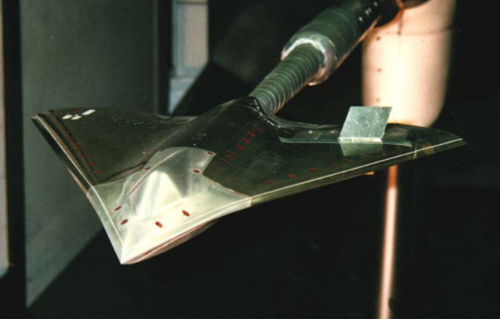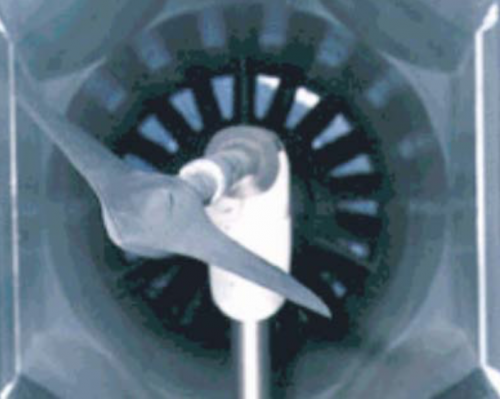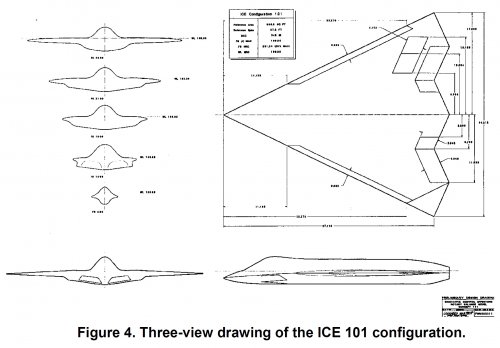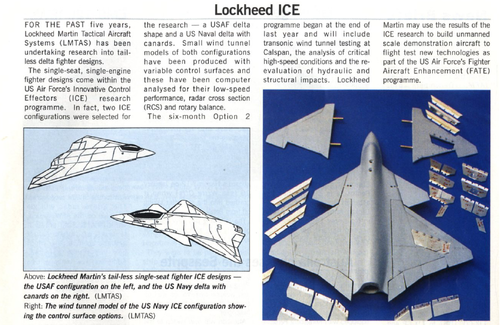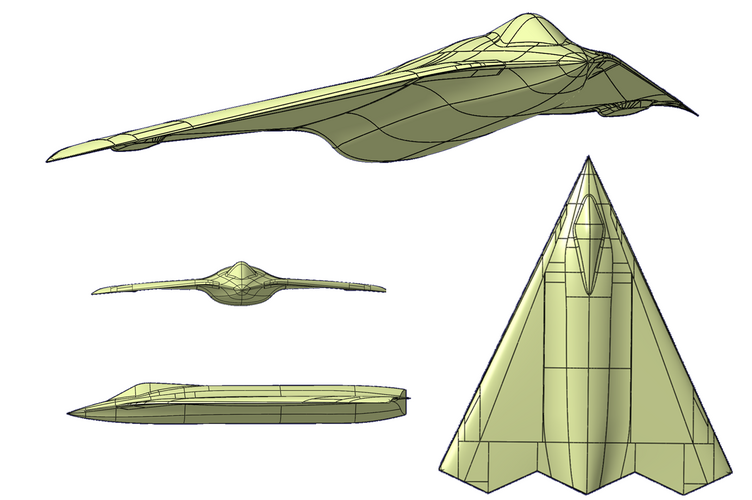Last week's X-36 rollout at the McDonnell Douglas Aerospace factory here revealed a design with a variety of control surfaces indicating its role of testing whether stealthy supersonic aircraft can also be agile.
The drone, a 28% scale version of a notional manned fighter, has two large canards, 10 trailing-edge surfaces and leading-edge flaps. It also has yaw-axis thrust vectoring and is mildly unstable in pitch and yaw.
The 1,270-lb. aircraft, a joint NASA/McDonnell Douglas project, is to start a 25-sortie, six-month flight test program at the Dryden Flight Research Center this summer. The flights will measure the reliability of design techniques, which have been tested so far with 3-15% scale wind tunnel models. X-36 development was led by Ames Research Center, and two aircraft are being built.
The X-36 has stealthy and supersonic features that tend to hurt agility, and designers believe that clever aerodynamics and flight control laws can overcome these problems. Agility-penalizing features include:
-- The lack of a vertical tail for low radar cross section (RCS), which makes it difficult to produce yaw forces. Instead, they are provided by wingtip drag rudders and thrust vectoring.
-- Chined fuselage for low RCS. This shape can create so much forebody vortex lift at high angle of attack (AOA) that it is hard to put the nose back down. The canards are used to overpower the forebody lift.
-- Sharp leading edges for low RCS and low supersonic drag. They make it difficult to efficiently produce high lift, but leading edge flaps and biasing other control surfaces may compensate.
-- A thin wing for low supersonic drag, which makes it difficult to install powerful actuators for large, rapid-rate controls. X-36 engineers reconfigured actuators for a lower profile. The 7% wing thickness is not much more than the 5-6% typical of a supersonic design, David J. Manley, McDonnell Douglas X-36 program manager, said.
The X-36 has a cranked-arrow wing and large canards, though it is officially ``tailless.'' The canards are mainly to provide nose-down moment, and help destabilize the aircraft in pitch.
The planform lines are aligned to keep major radar reflections along relatively benign aspects, and the chined fuselage bounces waves up or down away from most radar observers. The thin, broad ``platypus'' exhaust nozzle limits viewing up the tailpipe to a narrow range of angles, as well as spreading the plume for low infrared signature. The nozzle interior is likely designed to minimize retroreflection, although special radar-absorbing materials were not used in the X-36.
Because of the drone's 28% scale, actual radar-absorbing materials would not provide meaningful data.
The scarfed F/A-18E/F-style inlets are a gesture toward low observability, but as implemented with a large lip radius for low airflow distortion, they would not be too effective. The Y-duct to the center engine blocks the fan blades from head-on radar viewing, but they can be partly seen from a moderate side angle down one duct.
The aircraft's aft center of gravity makes it mildly unstable in pitch and yaw for increased agility. Software keeps it under control.
The wings have 2.5-deg. washout twist to prevent tip stall and compensate for canard downwash along the inner span. The wing and canard leading edges have a sharp radius of roughly 0.005 in. for low RCS and low supersonic drag. This, along with the sweep angle, means that high-AOA flight will be dominated by vortex lift, which can create high drag.
Each wing has four control surfaces. There are two split ailerons at the wingtip with independent upper and lower surfaces that can act as drag rudders and ailerons at the same time. The upper surface can move 60 deg. up and 30 deg. down, while the lower surface moves +30 deg., -60 deg., giving +/- 30 deg. of solid aileron motion, and twice that as a split aileron. They have a common hinge line at the lower wing surface so the tips don't rub when they move as a solid aileron. A flexible rub strip keeps the upper surface sealed to the wing as it moves. The split ailerons are broken into inboard and outboard surfaces to keep actuator loads acceptable and for redundancy, and the surfaces move in unison.
The inboard solid surface is an elevon used for roll and pitch, and it moves 30 deg. To increase maximum lift for takeoff and landing, all the trailing-edge surfaces bias down while the canard biases up to maintain trim and add lift.
The leading-edge flap is the fourth control and is programmed to deflect as much as 40 deg. down with increasing angle of attack and AOA rate, to prevent yaw-roll dihedral coupling from becoming uncontrollable at high AOA. The left and right sides are not mechanically connected, but software moves them in unison.
The controls move at rates similar to advanced fighters like the F-22. Actual model rates are about twice as fast owing to dynamic scaling. In practice, the leading edge flap moves slower than the other surfaces.
The 7% thin wing had little room for actuators, so Moog Inc. removed the control valves from its linear actuator bodies and relocated them to an inboard manifold. A linear variable differential transformer on the actuator senses position. The 3,000-psi. actuators produce 1,200-lbf. force over a 1.5-in. stroke and are about 6 in. long.
The canards are not mechanically connected but only move in unison for pitch control. Motion is 10 deg. nose up and 80 deg. nose down. Hydraulic power for all the controls comes from an Abex 3,000-psi., 7.4-gpm. electric pump with a small accumulator. The aircraft electrical system is powered by a 28-v, 200-amp Lucas starter/generator, and batteries provide about 5 min. of backup power.
Engineers originally planned to place flight control software in a Honeywell integrated flight management unit (IFMU) that contains the laser gyro inertial reference and GPS navigation, but the software grew beyond an easy fit into the IFMU. It now resides in a McDonnell Douglas computer originally designed for the actuator servo loop and air data sensor processing.
This computer uses seven Texas Instruments C (superscript) 3 1 digital signal processor chips for a total speed of 117 million instructions per second. It now processes the flight control laws at 100 Hz. while controlling the actuators at 1,000 Hz., as well as retaining its other original functions. Controlling a 28% subscale drone requires high computational rates because dynamic scaling makes things happen about twice as fast.
For simplicity, the X-36 will be manually piloted from a cockpit station in a control and data collection van. The pilot can look at a television screen showing cockpit-viewpoint video overlaid with head-up display symbology. The aircraft has an autopilot that can fly between waypoints.
With no force on the stick, the pitch control law holds a constant AOA, and AOA is proportional to stick force. This natural-handling scheme is relatively simple to use in the drone and may not represent manned aircraft control laws. AOA is limited to the 35-deg. point of maximum lift for this phase of flight tests, as wind tunnel spin tests have not been done. Roll rate is proportional to stick force and at high AOA the roll is around the velocity vector. Rudder pedals command sideslip at low AOA, blending to roll at high AOA.
Three gain settings can be used. Low and medium gain are used for takeoff, landing and most cruise operations. High gain gives very rapid response, with rates twice that of a full-scale fighter. An automatic routine can measure the response to individual control surfaces.
The thrust-vectoring system is yaw-only, not both yaw and pitch as previously reported, and is a McDonnell Douglas concept (AW&ST Mar. 4, p. 20). The Williams F112 turbofan cruise missile engine has a 0.85 bypass ratio to provide some cool air to the platypus nozzle, and the team added an eight-lobe daisy mixer in the engine exhaust to ensure uniform 800-900F temperatures, avoiding the risk of hot streaks in coaxial fan/core flow. The engine attaches with a band clamp to titanium ductwork to transition to the rectangular nozzle cross section. Fuselage skins around the exhaust are aluminum instead of graphite-epoxy to take temperatures up to 200F.
The vectoring is not necessary. Aerodynamic control power is great enough to overcome a hardover vectoring position. But vectoring can improve performance by allowing the drag rudders to remain closed for lower RCS and drag.
Engine inlets for the drone were designed to be low-risk, according to Dave Zilz, McDonnell Douglas propulsion and thermodynamic team leader. They have large lip radius and a contracting cross section to provide good airflow to the engine face. The penalty is excessive spillage drag from the oversized inlets. Maximum engine airflow is 14.6 lb./sec.
About $29-30 million will have been spent on X-36 from the start of development to the end of the first phase of flight test in early 1997. Broken down, Ames spent $12-13 million from 1989 through the start of detail design in February, 1994, with McDonnell Douglas under contract. From then until early 1997 Ames will spend another $7 million while McDonnell Douglas is providing $10 million for the detail design and construction of the two drones. The cruise missile engines were provided by the government.
THE OUTER MOLD LINES were frozen in June, 1994, and fabrication of the drones started in June, 1995. Structure of the second X-36 is now being assembled. The aircraft has a machined aluminum frame covered with carbon-epoxy fuselage and wing skins.
The X-36 was praised at the Mar. 19 rollout for meeting NASA's goals of ``faster, better, cheaper,'' by Robert Whitehead, NASA associate administrator for aeronautics. He said it was taking about one-fifth the cost and one-third the time of a conventional manned X-plane.
A key to this was avoiding redundant systems, Larry D. Birckelbaw, the Ames X-36 program manager, said. ``NASA Dryden told us their experience with Himat was that redundancy resulted in gold-plating,'' he said. Himat was a 3,000-lb. single-engine drone air-launched from a B-52 to test highly maneuverable fighter technologies.
``Himat had a lot of redundancy,'' Manley said. ``I estimate X-36 will be about one-fourth their cost.''
Most of the X-36 is single-string, including the radio link, flight control computer, air data and inertial reference systems. Loss of radio signal activates simple autonomous ``fly-home'' modes, and a Pioneer parachute aft of the cockpit can be deployed for an emergency landing. It is bridled to land the aircraft in a flat attitude at the 14-fps. landing-gear sink rate limit.
The disadvantage of the X-36 single-string approach is possible higher risk, but this is addressed by building two of the aircraft. The X-36 is also freed of relying on the B-52 by being able to take off and land by itself.

